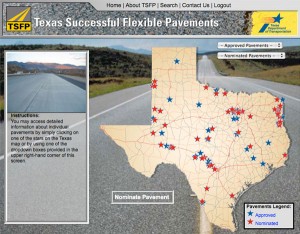
The Texas Department of Transportation (TxDOT) has taken great efforts over the years to learn from pavements not performing as well as expected. But it is also possible to learn much from successes. The Texas Transportation Institute (TTI) recently conducted a research project to establish a process for TxDOT to use to learn from Texas flexible pavements that have performed notably. As a result, the research team developed a database where information about these pavements could be stored, searched and downloaded through a website interface.
“We began this project by contacting TxDOT‘s 25 districts and asking them to nominate pavements that their staffs believed have performed in a superior fashion considering all factors involved,” says TTI Research Engineer Paul Krugler, who led the project team. “The final selection of pavements considered the need to represent a wide variety of flexible pavement structure types, asphalt mixture types and the broad geographical area of the state.”
After the research team gathered preliminary information about each nominated pavement section, members visited with personnel from each nominating district to view and discuss the pavement section’s history. The information was then analyzed to gain insights into why certain pavement characteristics result in superior performance. Researchers then compared that information with current specification requirements to assess the appropriateness of specification criteria.
The key research findings include the following:
- While the success of each pavement appears to involve somewhat differing factors, in general, superior performance may be attributed to the combined result of good construction practice, high-quality materials and timely maintenance.
- Analysis of data from the 25 pavement sections reflects superior pavement performance over time. Average condition scores, distress scores and ride scores from data available from 1998 through 2006 indicate very good performance and validate the selections of these pavements by the districts.
The website allows online nomination of additional pavement sections by personnel and is made available to all potential department users to gain immediate and maximum benefit from the information now available.
“The database provides TxDOT area engineers and district pavement engineers with quick access to flexible pavement designs of various types that have been particularly successful,” says Krugler. “It also provides valuable information for materials engineers to evaluate the adequacy of specification criteria on an ongoing basis.”
The website is located at http://tsfp.tamu.edu. Technical report 0-5472-1, Analysis of Successful Flexible Pavement Sections in Texas — Including Development of a Web Site and Database, details the development of the database and website.
